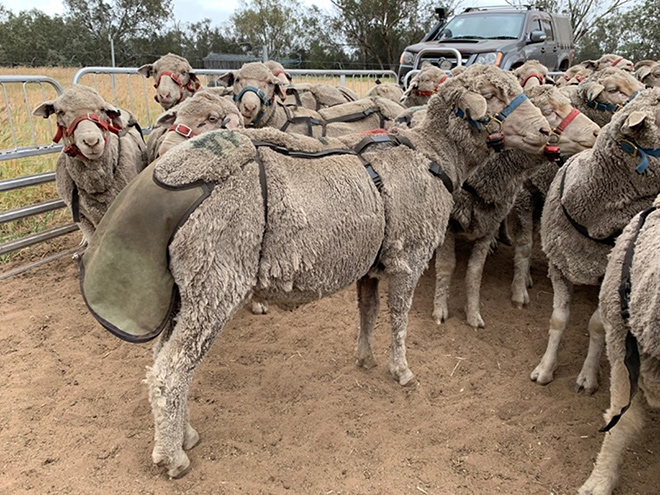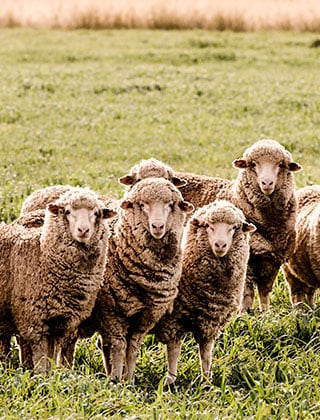Grazing Bytes

A three-year project, aptly titled ‘Grazing Bytes’, has demonstrated that AWI smart tags can be used to predict feed intake and especially liveweight change, which could thereby enable woolgrowers to optimise grazing decisions. This would improve both pasture and animal performance.
Sheep fitted with faecal harnesses and bags to collect total faecal excretion during the project’s experiments.
Smart tags for monitoring grazing behaviour
A three-year project, aptly titled ‘Grazing Bytes’, has demonstrated that AWI smart tags can be used to predict feed intake and especially liveweight change, which could thereby enable woolgrowers to optimise grazing decisions. This would improve both pasture and animal performance.
AWI’s investment in smart tags aims to enable woolgrowers to track, monitor and assess the status of their flock in real time – and make more informed decisions to increase their enterprise’s profitability.
The objective of the recent Grazing Bytes project was to utilise AWI smart tags to assess grazing behaviour, feed intake and ultimately accurately predict liveweight change. The AWI project, run by Murdoch University and NextGen Agri with support from the Muresk Institute in WA, was completed earlier this year.
At the beginning of the project in 2019, farmer workshops were held across a range of Australia’s sheep producing regions (WA, SA, Vic, NSW) to gain insights from a broad range of producers on the kinds of use cases they would envisage and the format they would like the information to be in. However, all research work was undertaken in WA due to COVID restrictions.
The smart tag data generated during the project was matched with known feed intake information and liveweight change information generated in a range of scenarios. The data sets were then used to train and test machine learning algorithms to predict a range of grazing and liveweight change attributes. The results were very promising.
“The Grazing Bytes project clearly and successfully demonstrated that AWI smart tags could be used be used to predict both feed intake and especially liveweight change,” said AWI Program Manager Agri-Technology, Carolina Diaz.
The most promising result was the ability to accurately predict liveweight change over seven days from smart tag behaviours (grazing, walking and ruminating) over the same period. Whilst the data sets were small, almost 70% of the actual changes in liveweight over seven days were explained by the predicted changes in liveweight.
Furthermore, the predictions of liveweight change appeared to be independent of the plot and feed on offer (FOO) and therefore, if validated using larger data sets, the approach may be transferable across different grazing environments and scenarios.
Carolina says the implementation of this technology in due course would likely have a positive impact on labour efficiency, farm productivity and business profitability.
“The prediction of grazing behaviour, feed intake and liveweight change from the AWI smart tags could ultimately be used to develop paddock movements that optimise the utilisation of feed available across the farm at different times of the year. It could also enable more efficient and timely use of supplementary feed,” she said.
“The data, even on a weekly basis, would make it much easier to allocate the appropriate amount of feed to priority mobs and increase the accuracy of achieving condition score targets to improve reproduction and lamb marking rates.
“Together with information on location, the data could also provide spatial information on forage productivity that could be used to improve paddock management and design.”
Other AWI smart tag research
In addition to the above Grazing Bytes project, AWI has invested in projects that investigate sheep behaviour in relation to predation/welfare and reproduction.
Remote detection of predation and disease
As reported in the June edition of Beyond the Bale, a three-year project completed earlier this year highlighted the potential of AWI smart tags to indicate the presence of wild dogs around sheep, and detect the early incidence of health issues in sheep (eg Barber’s pole worm infections) – both of which can have significant production, profitability and animal welfare implications. The ultimate potential and benefit will be when real-time alerts are able to be generated to enable woolgrowers to intervene. The three-year project was undertaken by CQUniversity with funding from AWI and an Advance Queensland Industry Research Fellowship.
Improving reproductive management
An ongoing project with the University of Sydney aims to understand male and female reproductive behaviour and how it can be detected using AWI smart tags. Monitoring such behaviour has historically been time consuming and labour intensive, however this project has been exploring how AWI smart tags could be implemented so woolgrowers could increase reproductive efficiency in their flocks. Experiments have been conducted to measure/identify the physical event of rams mounting ewes, with tags on both the ewes and rams. Tags capable of monitoring the mounting have been developed, with the algorithm having a sensitivity of 91% and precision of 86%.
This article appeared in the December 2022 edition of AWI’s Beyond the Bale magazine. Reproduction of the article is encouraged.















